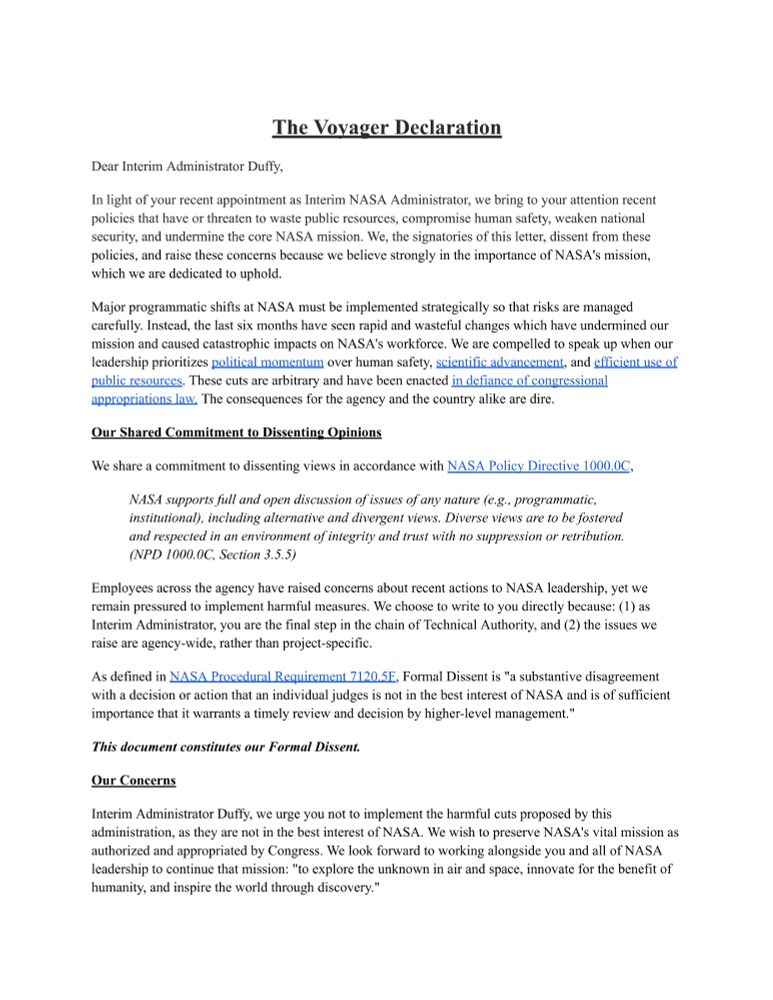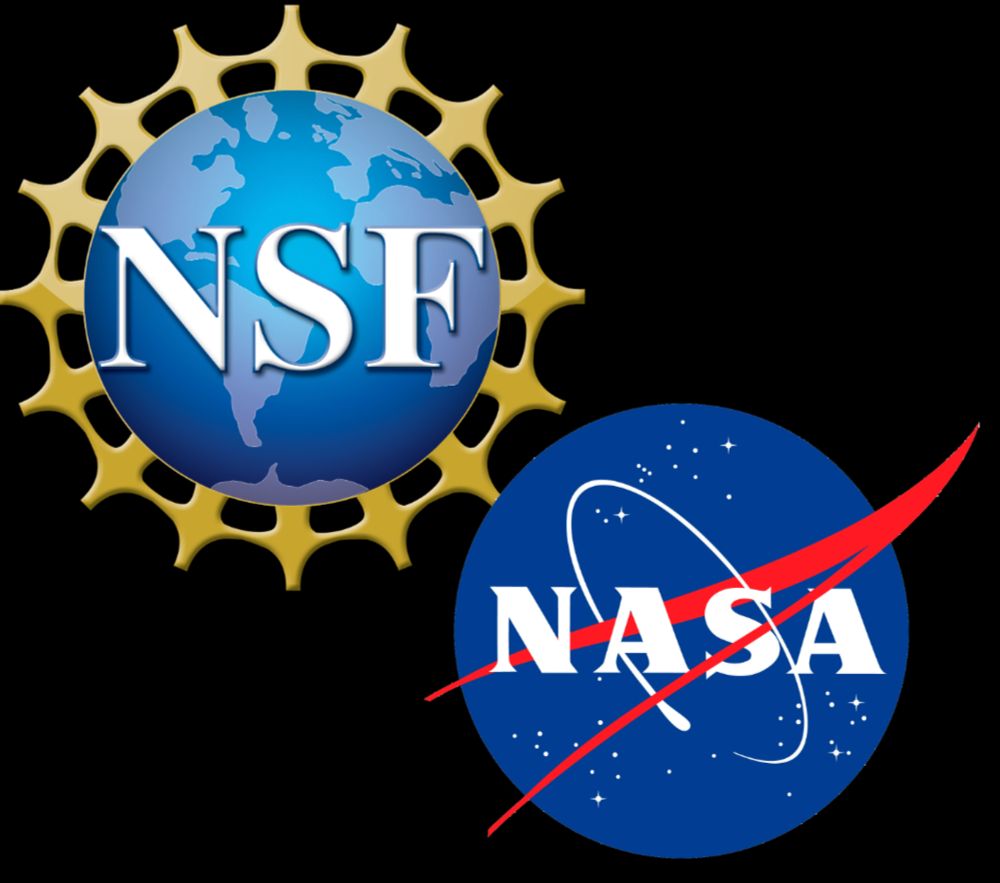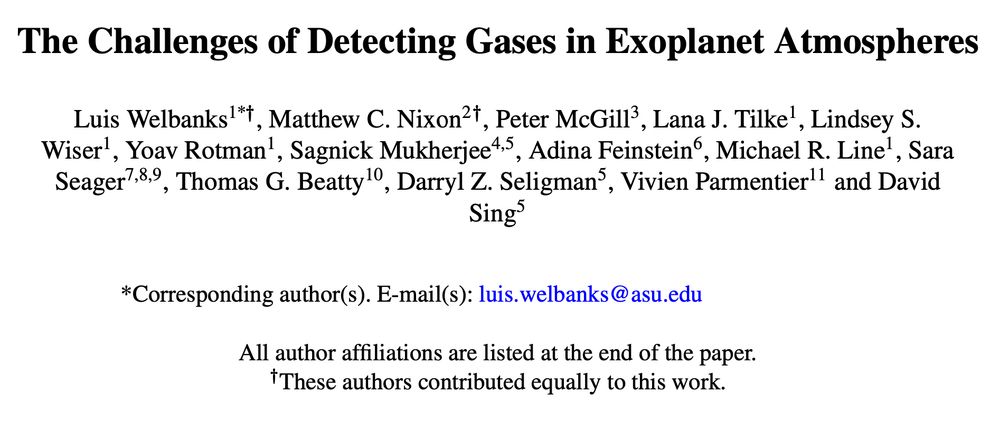
Hey, astronomers. Can you imagine astronomy research without ADS?!?!? No? So, have you filled out the ADS survey yet?
Help archives help you!
(Help archives keep funding!)
docs.google.com/forms/d/e/1F...
@yoavrotman.bsky.social
PhD Candidate 🪐 @ ASU || UMD Astro '22 🐢 || studying exoplanet atmospheres and a big fan of TRAPPIST-1e || sometimes I play the trombone || he/him/הוא || find me on Twitter @Yoav_Rotman

Hey, astronomers. Can you imagine astronomy research without ADS?!?!? No? So, have you filled out the ADS survey yet?
Help archives help you!
(Help archives keep funding!)
docs.google.com/forms/d/e/1F...

The JWST Cycle 5 "Procrastination Monitor", i.e. Molly's proposal counter submission form, is up an running. Please fill it out if you have data to add to it. And do share! #JWSTCycle5
docs.google.com/forms/d/e/1F...

Do you love WASP-107 b? Do you love making use of *both* ground VLT + space JWST obs to detect molecules in a "warm" (Teq<800K) #exoplanet in transmission, even in a crazy confusing cloudy atmosphere?!
🚨 It's PAPER* DAY! Which means #scicomm thread!
🧵⬇️🔭🪐🧪
*pre-print!
arxiv.org/abs/2508.18964
3.12 עמודים/קפה זה יחס טוב?
19.08.2025 18:43 — 👍 1 🔁 0 💬 1 📌 0
The Voyager Declaration Dear Interim Administrator Duffy, In light of your recent appointment as Interim NASA Administrator, we bring to your attention recent policies that have or threaten to waste public resources, compromise human safety, weaken national security, and undermine the core NASA mission. We, the signatories of this letter, dissent from these policies, and raise these concerns because we believe strongly in the importance of NASA's mission, which we are dedicated to uphold. Major programmatic shifts at NASA must be implemented strategically so that risks are managed carefully. Instead, the last six months have seen rapid and wasteful changes which have undermined our mission and caused catastrophic impacts on NASA's workforce. We are compelled to speak up when our leadership prioritizes political momentum over human safety, scientific advancement, and efficient use of public resources. These cuts are arbitrary and have been enacted in defiance of congressional appropriations law The consequences for the agency and the country alike are dire. Our Shared Commitment to Dissentin� Opinions We share a commitment to dissenting views in accordance with NASA Policy Directive 1000.0C, NASA supports full and open discussion of issues of any nature (e.g., programmatic, institutional), including alternative and divergent views. Diverse views are to be fostered and respected in an environment of integrity and trust with no suppression or retribution. (NPD 1000.0C, Section 3.5.5) Employees across the agency have raised concerns about recent actions to NASA leadership, yet we remain pressured to implement harmful measures. We choose to write to you directly because: (I) as Interim Administrator, you are the final step in the chain of Technical Authority, and (2) the issues we raise are agency-wide, rather than project-specific. As defined in NASA Procedural Requirement 7120 5F, Formal Dissent is "a substantive disagreement with a decision or action that an indiv…

• We dissent to changes to NASA's Technical Authority capacities that are driven by anything other than safety and mission assurance. The culture of organizational silence promoted at NASA over the last six months already represents a dangerous tum away from the lessons learned following the Columbia disaster. Changes to the system of Technical Authority, as suggested would be made in the June 25th NASA Town Hall, should be made only in the interests of improving safety, not in anticipation of future budget cuts. • We dissent to the closing out of missions for which Congress has appropriated funding because it represents a permanent loss of capability to the United States both in space and on Eatlh. Once operational spacecraft are decommissioned, they cannot be turned back on. Additionally, cancelling missions in development threatens to end the next generation of crucial observations. • We dissent to implementing indiscriminate cuts to NASA science and aeronautics research because this will leave the American people without the unique public good that NASA provides. Basic research in space science, aeronautics, and the stewardship of the Earth are inherently governmental functions that cannot and will not be taken up by the private sector. Furthermore, NASA has a nearly threefold return on investment in economic activity, and supports national security by ensuring the United States maintains its lead in science and technology. • We dissent to NASA's non-strategic staffing reductions because they will jeopardize NASA's core mission. Thousands of NASA civil servant employees have already been terminated, resigned or retired early, taking with them highly specialized, irreplaceable knowledge crucial to carrying out NASA's mission. • We dissent to canceling NASA participation in international missions because in doing so, NASA is abandoning America's allies. To date, 55 nations have signed on to the Artemis Accords, and withdrawing support from missions with our long-s…

We stand in solidarity with our colleagues at the NIH and EPA who have released similar statements concerning the administration's actions at their respective agencies. We dedicate this letter to Gus Grissom, Ed White, Roger Chaffee, Dick Scobee, Michael J. Smith, Ronald McNair, Ellison Onizuka, Judith Resnik, Gregory Jarvis, Christa McAuliffe, Rick Husband, Willie McCool, Michael Anderson, Kalpana Chawla, David Brown, Laurel Clark, and Ilan Ramon. Their legacies underpin every conversation about our shared commitment to safety and dissenting opinions at NASA.
NEW: Hundreds of NASA employees have filed a letter of formal dissent.
"We are compelled to speak up when our leadership prioritizes political momentum over human safety, scientific advancement, and efficient use of public resources. The consequences for the agency and the country alike are dire."
I got no tips on the aesthetics 😭 but I did have an absolutely awesome team support me by checking content and helping me practice and that made all the difference
09.07.2025 02:49 — 👍 1 🔁 0 💬 0 📌 0Interpretation of #JWST exoplanet transmission spectroscopy hinges on having accurate error bars on the spectra. Correlated noise will come to bite you if you don’t model it appropriately. So this is great and important work, thanks @yoavrotman.bsky.social & al 👇🔭🧪
09.07.2025 02:43 — 👍 17 🔁 3 💬 1 📌 0We need to understand the limits of our models and our data for reliable interpretations of exoplanetary spectra.
First paper by my first PhD student! Happy advisor moment. Congrats @yoavrotman.bsky.social
Check out his paper on the Arxiv and his thread below #exoplanets 🔭
Speaking of which, I'll be presenting this work later today at @exoclimes.bsky.social. Check out my talk at 5:00 if you're interested in learning more!
#ExoclimesVII

The title and authors/affiliations of our new paper.
This paper is now accepted in ApJ and the latest version is on arXiv as of last night, so go check it out! A huge thanks to the coauthors on here: @luiswel.bsky.social @astropeter.bsky.social @nixonmatthew.bsky.social
arxiv.org/abs/2503.21702
(13/13)

A meme showing a blissfully unaware man labeled "Unknowns in JWST data", with a menacing man standing behind him labeled "Retrievals with GPs".
So does all this mean everything we've ever done is wrong? Absolutely not! GPs just present a new, statistically robust, more flexible modeling methodology for exoplanetary spectra that can provide insights into not just our data, but our models themselves!
(12/n)

The correlation hyperparameters. The amplitude is about 75 ppm, and the length scale is about 0.014 microns.
In fact, we also see that the GP identifies a distinct global correlation in the NIRISS data, which is not unexpected from instrumental effects. At ~75 ppm, this is not a massive oversight, but something for future NIRISS enthusiasts to be aware of.
(11/n)

The posterior distributions for the local kernel wavelengths, telling us where data and model cannot match. One is at 1.18 microns, and one is at 2.7 microns.
In fact, if a local kernel is placed, it falls on the CO2 feature at 2.7 microns, telling us that perhaps CO2 characterization with NIRISS is less robust than previously expected. That doesn't mean this is necessarily the case, but it's a good diagnostic already!
(10/n)

The abundances constrained from the spectrum of WASP-96b. H2O gets a wider constraint when a GP is used, and the CO2 abundance gets a tail towards -12.
Very possibly! We find that including GP kernels hint at wider H2O and CO2 abundance distributions than traditional retrievals. The latter even has a tail that contains the values from *both* previous estimates!
(9/n)

4 different analyses of the spectrum of WASP-96b, with different GP parameterizations. The GP parameterizations show a wider range of models fitting the data well.
We then analyze the *real* NIRISS spectrum of WASP-96b! Previous analyses (Radica et al. 2023, Taylor et al. 2023) largely agree, but found discrepancies in their CO2 abundance. Can GPs help?
(8/n)
This can help us understand our modeling deficiencies and/or data wonkiness at a much better level than before, so we can push towards more complete models!
"Well that's great Yoav," you say, "but what about real observations?"
Glad you asked!
(7/n)

The GP hyperparameters, showing that the wavelength of the "mystery" feature is constrained correctly, alongside the amplitudes and length scales of the GP kernels.
Not only that, but the parameters of the GP ("hyperparameters") actually contain information! By analyzing the GP kernels, we can get an understanding for how much correlation there is in our data and *where* our model cannot fit it.
(6/n)

Histograms of the abundances of various gases. GP histograms significantly less bias (distance from the true value) than the histograms from traditional retrievals.
Yes! The traditional retrieval (black histograms) not only can't account for the injected feature, but it actually biases all our inferences. Different GP parameterizations (blue/pink/purple) give significantly less biased, more reliable answers.
(5/n)

A synthetic spectrum of WASP-96b, a hot Saturn. It shows the contribution from different molecules, as well as an injected correlation with a feature at 1.65 microns.
We kick this off by creating a synthetic spectrum of WASP-96b, where we inject some underlying correlation and a "mystery" feature at 1.65 microns, that we *know* our model can't account for. Will a GP work better?
(4/n)

An idealized demonstration of different covariance kernels, showing how they can be stacked. A global kernel appears throughout the spectrum but a local kernel is limited to a particular wavelength range.
We use a GP that looks for a) global correlations throughout the spectrum that may come from instrumental effects and b) localized correlations that manifest where the model can't explain the data!
(3/n)
We set out to fix this problem with Gaussian Processes (GPs). GPs help account not only for the model but also for any underlying correlation. By "GP-ifying" retrievals of transmission spectra, we can actually *relax* assumptions about model completeness and noise.
(2/n)

A meme saying "Correlated noise? In my JWST data? It's more likely than you think. FREE GP CHECK!"
Paper day! A 🧵
JWST transmission spectra are showing more and more signs of new exciting physics, which is awesome! But if our models don't take that into account, it can propagate as correlated noise and bias our inferences. What do we do?
arxiv.org/abs/2503.21702
(1/n)
Astro folks, does anyone have any good tips for making conference talk slides? Looking for stuff beyond the usual "don't overclutter" and "spread the information over multiple slides" - any tips about how to make an aesthetically pleasing, easy to follow deck?
27.06.2025 16:55 — 👍 0 🔁 0 💬 1 📌 0
Need data to explain the disastrous proposed cuts to NASA?
Here are seven charts that lay out why The White House’s FY2026 budget proposal poses a historic threat to NASA. www.planetary.org/articles/nas...

From Skylar Grayson @skylargrayson.bsky.social : This post summarizes the proposed major cuts to NASA and the NSF and the impacts they would have, and provides resources to help fight back against this wasteful and unnecessary attack on science. 🔭✨☄️
astrobites.org/2025/06/02/b...
Here is the updated version of the FY26 president's proposed #NASA astrophysics budget for current+future missions. The technical supplement document does have significantly reduced funds for NuSTAR, IXPE, TES (+HST, JWST, Roman), so I removed those Xs, but these are at/below bare minimum levels. 🔭
31.05.2025 16:23 — 👍 52 🔁 36 💬 5 📌 10Have we as a society figured out definitively if there's supposed to be a space before the letter in an exoplanet name? "TRAPPIST-1 e" looks wrong but so does "WASP-96b"
24.05.2025 19:07 — 👍 2 🔁 0 💬 2 📌 0
Just shared a new paper on the arXiv, led my @luiswel.bsky.social and me, on the challenges associated with detecting gases in exoplanet atmospheres. As the field pushes towards new and exciting opportunities, we thought it was time to talk about what it really means to “detect” something!
02.05.2025 01:29 — 👍 31 🔁 7 💬 1 📌 2This is an awesome paper!!
02.05.2025 04:08 — 👍 1 🔁 0 💬 0 📌 0